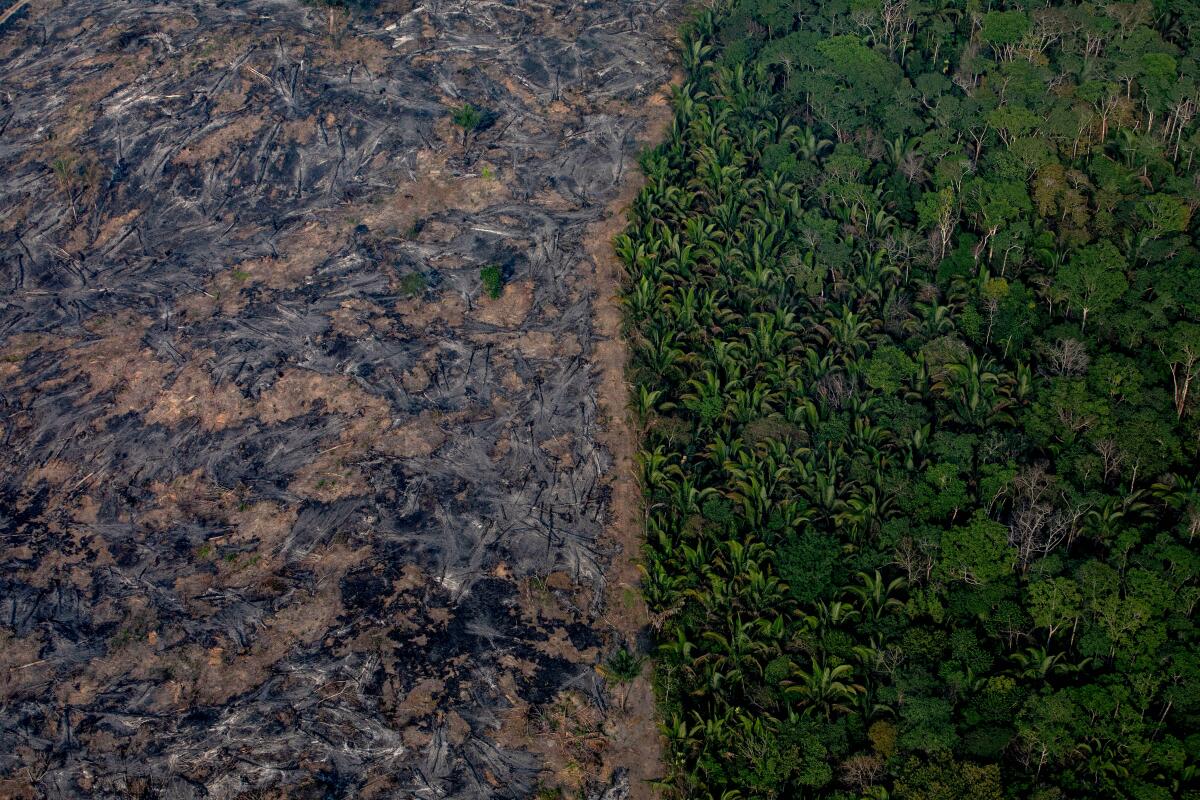Opinion: California can help save the Amazon rainforest. Do we have the guts to try?

Fires burning in Brazil and the broader Amazon basin are shining a spotlight on the role of forests and land use in the climate change challenge. Next week, the California Air Resources Board will hold a hearing that could have a direct impact on such fires.
On Sept. 19, the board will vote on whether to endorse its proposed Tropical Forest Standard. California has been working on this standard for 11 years through a unique partnership with 37 other states and provinces from 10 countries around the world, including all of the states in the Brazilian Amazon. Full disclosure: I have served as the project lead for this effort since its inception.
At its core, the Tropical Forest Standard establishes a set of performance benchmarks for what a high-quality state or provincial approach to reducing deforestation should aim for. States or provinces that meet the standard might be eligible in the future to raise money to fund sustainable practices by participating in the California carbon cap-and-trade system. Emitters in California — an oil company, say — would purchase offsets tied to emissions reduction in the forest provinces. That then allows the oil company to meet part of its compliance obligations here. But even if these faraway forest offsets are never bought and sold in our carbon market, jurisdictions that meet the benchmarks could use the standard to access other opportunities.
Much of the proposed standard is technical, relating to quantification of emissions reductions, monitoring and verification. Some of it is focused on process and governance issues, establishing a robust set of principles for what constitutes proper collaboration between state and provincial governments and indigenous and local communities. These principles have been jointly developed and are now widely endorsed by governments, indigenous peoples organizations and civil society groups around the world. There is nothing in the world today like the Tropical Forest Standard, and we should not hold our breath waiting for the United Nations or national governments to fill that gap.
Critics have already decided that the Tropical Forest Standard cannot possibly work. They point out that it will be difficult to verify and enforce the benchmarks. They worry that because of that, the program may just make it easier for large emitters in California to buy dubious offsets and continue emitting.
And, of course, even if it does work, the Tropical Forest Standard cannot solve the problem of tropical deforestation by itself.
But the standard is worth trying. Like so much of California’s approach to climate policy, it is an experiment, one that has a lot of potential upside with very limited downside risk. The program contains multiple safeguards to protect the integrity of the California cap-and-trade program. Even if a jurisdiction can meet the standard, there is no guarantee that it would be able to link with California’s program. Before that could happen, it would have to gain further approval in Sacramento. It is quite possible that California could adopt the Tropical Forest Standard and never pursue a linkage with a tropical forest jurisdiction.
Why then move forward with it? Two reasons. First, the standard sends an important signal to California’s tropical forest partners that they are not in this alone. Abandoning the standard now would do the opposite. This is especially critical for forest states in Brazil now that the federal government has pulled back from forest protection. Governors in Brazil, Peru or Mexico might feel a little more comfortable taking some political risks to step up on forests and climate if they can point to an ongoing partnership with California. In a world of triage and tragic choices, every little bit of courage by a political leader is a precious resource.
Second, states and provinces that meet the standard’s criteria would be in a much better position to unlock more sources of public and private financing, even if the offsets aren’t part of our cap-and-trade market.
Without a doubt, many of these tropical forest jurisdictions are poor, with limited capacity and far too little support from national and international partners. And, yes, in many of these tropical frontiers, there are problems of corruption, illegal land grabs, narco-trafficking and violence against indigenous and local communities. We can’t solve these problems by ignoring them, and the standard is a way of engaging them.
The great risk is that leaders in those tropical forest provinces who are committed to sustainable efforts will give up or lose the next election. They need and deserve our support. They need to know that the world is watching and that if they stay on the path of forest protection their efforts will be recognized and rewarded. More than anything, they need to be able to make a compelling case to the people in their jurisdictions that forest protection can deliver meaningful economic opportunities.
California has a chance to do its part in this effort by staying in the fight alongside these states and provinces. This is what climate leadership looks like in a bottom-up world.
William Boyd is a professor at the UCLA School of Law and the UCLA Institute of the Environment and Sustainability. Since 2009, he has served as the project lead for the Governors’ Climate and Forests Task Force.
More to Read
A cure for the common opinion
Get thought-provoking perspectives with our weekly newsletter.
You may occasionally receive promotional content from the Los Angeles Times.










